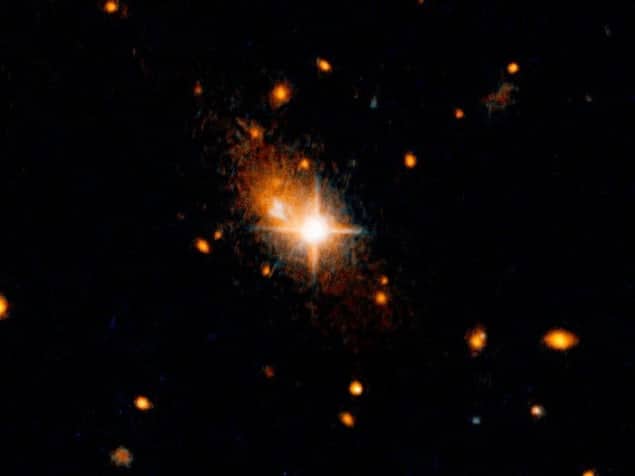
Astronomers using the Hubble Space Telescope have spotted a supermassive black hole that has been propelled out of the centre of the galaxy where it formed. They reckon the huge object was created when two galaxies merged and was then ejected by gravitational waves.
The discovery centres on galaxy 3C186, which lies about eight billion light-years from Earth and contains an extremely bright object that astronomers believe is a black hole weighing about one billion Suns. Most large galaxies, including our own Milky Way, contain such supermassive black holes at their cores, with these huge, bright objects being powered by radiation given off by matter as it accelerates into the black hole.
What is unique about this black hole, however, is that it is not at the centre of the galaxy but rather about 35,000 light-years away – a distance equivalent to a third of the diameter of the Milky Way. Moreover, the scientists believe that the black hole is moving away from the galactic core at 7,500,000 km/h – the speed at which a journey from the Earth to the Moon would take just 3 min.
“We estimate that it took the equivalent energy of 100 million supernovae exploding simultaneously to jettison the black hole,” explains Stefano Bianchi of the University of Rome Tre, who was involved with the discovery.
The astronomers believe that this vast energy was liberated when two galaxies, each with its own supermassive black hole, collided. The two black holes orbited each other before coalescing to form the black hole we see today. If the black holes had different masses and internal rotation rates, the merger would have created gravitational waves that were more intense in one specific direction. This, the astronomers believe, gave the merged black hole the kick that sent it on its way out of the galaxy – a journey that it has been on for one to two billion years.
Strong evidence
While the LIGO gravitational-wave detectors have recently found evidence that much smaller stellar-mass black holes can merge, it is not clear if supermassive black holes could coalesce. “If our theory is correct, the observations provide strong evidence that supermassive black holes can actually merge,” says Bianchi.
The mass and speed of the black hole was determined by doing a spectroscopic study of light emitted from gas surrounding the object. The team has secured more observation time on Hubble and the ALMA array of radio telescopes in Chile.
The observations will be described in Astronomy and Astrophysics.



